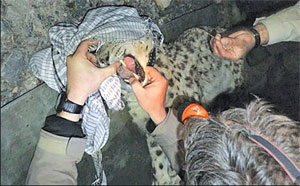Tracking snow leopards
Two snow leopards were captured, fitted with satellite collars, and
released for the first time in Afghanistan by a team of Wildlife
Conservation Society (WCS) conservationists and Afghan veterinarians
conducting research during a recent expedition.
|

Snow leopard being fitted with a satellite collar. |
The team successfully captured and released the male snow leopards on
May 27 and June 8 respectively. Each cat was weighed, measured, fitted
with a Vectronix satellite collar, and DNA samples were taken. After DNA
samples, the healthy snow leopards were released and headed up the Hindu
Kush Mountains in good condition. The big cats will be tracked by WCS to
better understand their behaviour and range. So far, the first snow
leopard, Pahlawan, has travelled more than 125 kilometers; while the
second cat, Khani Wakhai, has travelled more than 153 kilometres.
The snow leopard is an alpine rock-climbing specialist with large
paws that are ideally adapted to both rocky terrain and deep snow drifts
and thick fur to stay warm.
David Lawson, WCS Afghanistan Country Director, said: "These captures
are sensational. They are also a real tribute to the knowledge of the
local community rangers and the success of our recent camera trapping
efforts, which enabled the team to select spots that were known to be
frequented by snow leopards."
The range of the snow leopard includes about 2 million square
kilometres across 12 nations in Asia from Russia to Nepal. It is the
apex predator and a flagship species for one of the last great
wilderness regions on earth -- the spectacular mountain ranges of Asia,
including the Himalaya, Karakoram, Hindu Kush, Pamir, Despite survival
skills such as spectacular leaping ability and colouring that
camouflages them to near invisibility on the rocky alpine slopes of
their native habitat, the snow leopard faces threats that are bringing
this species closer to extinction. Snow leopards have been categorised
as an Endangered Species on the IUCN's Red List since 1972, and the
species is listed as endangered by almost all range countries.
Snow leopard populations are still thought to be dwindling across
most of their range. Some 3,000 to 7,500 leopards are thought to exist.
 Peter
Zahler, WCS Deputy Director of Asia Programmes, said: "The information
garnered from the tagging will assist researchers as they learn more
about the range, behaviour, movements, and habitat used by snow
leopards. This information in turn will help us in our partnership with
the Afghan Government and local communities to design protected areas
and management strategies to optimize the conservation of this big cat." Peter
Zahler, WCS Deputy Director of Asia Programmes, said: "The information
garnered from the tagging will assist researchers as they learn more
about the range, behaviour, movements, and habitat used by snow
leopards. This information in turn will help us in our partnership with
the Afghan Government and local communities to design protected areas
and management strategies to optimize the conservation of this big cat."
While this is the first collaring effort in Afghanistan, WCS
supported the first ever radio-collar study of snow leopards in
Mongolia's Gobi Altai Mountains in the 1990s under the leadership of Dr.
George Schaller.
First ever videos of snow leopard
mother and cubs
Meanwhile for the first time, the den sites of two female snow
leopards and their cubs have been located in Mongolia's Tost Mountains,
with the first known videos taken of a mother and cubs, located and
recorded by scientists from Panthera, a wild cat conservation
organization, and the Snow Leopard Trust (SLT).
Because of the snow leopard's secretive and elusive nature, coupled
with the extreme and treacherous landscape which they inhabit, dens have
been extremely difficult to locate. This is a tremendous discovery and
provides invaluable insight into the life story of the snow leopard.
Dr. Tom McCarthy, Executive Director of Panthera's Snow Leopard
Program stated, "We have spent years trying to determine when and where
snow leopards give birth, the size of their litters, and the chances a
cub has of surviving into adulthood. This is one of those exceptional
moments in conservation where after years of effort, we get a rare
glimpse into the life of an animal that needs our help in surviving in
today's world. These data will help ensure a future for these incredible
animals."
- ScienceDaily |

